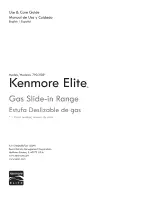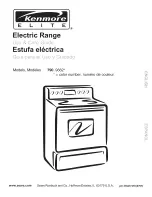
26
27
Convection Roast
For best results use the broiler pan. The pan is used to catch grease spills and has a cover to prevent grease
splatter.
The convection fan circulates heated air around the food being roasted, sealing juices quickly for a moist and
tender product while, at the same time, creating a rich golden-brown exterior.
Use the broil/roast pan and slotted grid supplied with the range when roasting in order to elevate the meat on a
metal roasting rack. This allows hot air to circulate around the meat, browning it more evenly like a rotisserie.
A
suitable roasting rack can be purchased through Customer Care at: +1-888-784-3108.
When roasting larger items like a whole turkey, use only the pan and grid for greater stability.
Convection Defrost
With temperature control off, a motorized fan in the rear of the oven circulates air. The fan accelerates natural
defrosting of the food without heat. To avoid illness and food waste, do not allow defrost food to remain in the
oven for more than two hours without being cooked.
Defrosting
To thaw uncooked frozen food, set the oven temperature to 100°F - 150°F. Once thawed, cook the food imme-
diately and do not refreeze.
To prevent liquid from thawing food dripping on the oven floor, be sure any uncooked food is tightly wrapped in
foil and/or placed in a container.
Convection Dehydration
With the temperature control on 175°F, warm air is radiated from the bake burners on the bottom of the oven
cavity, and is circulated by a motorized fan in the rear of the oven.
Over a period of time, the water is removed from the food by evaporation. Removal of water increases growth
of microorganisms and detains the activity of enzymes.
Broiler Operation
Note: Door must be closed during broiler operation.
Broiling is a method of cooking tender cuts of meat directly under the broiler in the oven. Broiling in the oven is
accomplished with the oven door closed. It is normal and necessary for some smoke to be present to give the
food a broiled flavor.
If you open the oven door to check the food, have it open for as short a time as possible. This is to prevent the
control panel from overheating and prevents melted knobs.
Use both the broil/roast pan and slotted grid supplied. The grid helps to reduce smoking and splatter by letting
grease drip into the bottom of the pan, away from intense heat. To prevent food sticking, spray the grid with a
light coating of non-stick cooking spray.
Oven Functions / Broiler Operation
Broiler Operation
Preheating
Preheating is suggested when searing rare steaks (Remove the broiler pan before preheating with the broiler.
Foods will stick to hard metal). To preheat, turn the “Oven” selector knob to the “Broil” position. Wait for the
burner to become hot, approximately 2 minutes. Preheating is not necessary when broiling meat well-done.
To Broil
Broil one side until the food is browned; turn and cook on the second side. Season and serve.
Always pull the rack out to the “stop” position before turning or removing food.
Setting Broil
The “Oven” selector knob controls the Broil feature. When broiling, heat radiates downward from the oven broiler
for even coverage. The Broil feature temperature is 500°F (260°C).
The broil pan and insert used together allows dripping grease to drain and be kept away from the high heat of
the oven broiler. DO NOT use the broil pan without the insert.
DO NOT cover the broil pan insert with foil. The exposed grease could catch fire.
To set the oven to Broil:
1.
Place the broiler pan insert on the broiler pan. Then place the food on the broiler pan insert.
2.
Arrange the interior oven rack and place the broiler pan on the rack. Be sure to center the broiler pan and posi-
tion directly under the broil burner. If preheating the broil burner first, position the broiler pan after the broil burner
is preheated.
3.
Turn selector knob to Broil.
The oven indicator light will remain on until the selector knob is turned to the off position or the temperature con-
trol cycles off.
Broiling guidelines
Choose a suitable shelf position. To ensure that meat is cooked through rather than just browned on the outside,
broil thick pieces of meat and poultry on shelf positions 2 or 3. Use shelf position 4 for thinner items that need
less cooking time like steaks, chops, or hamburger patties.
When finishing off meals by browning the top under the broiler, use metal or glass-ceramic bakeware. Do not use
heatproof glass or earthenware, as these cannot withstand the intense heat of the broiler.
Center the item in the oven, so that it is directly under the broiler.
3
8
3
9














































